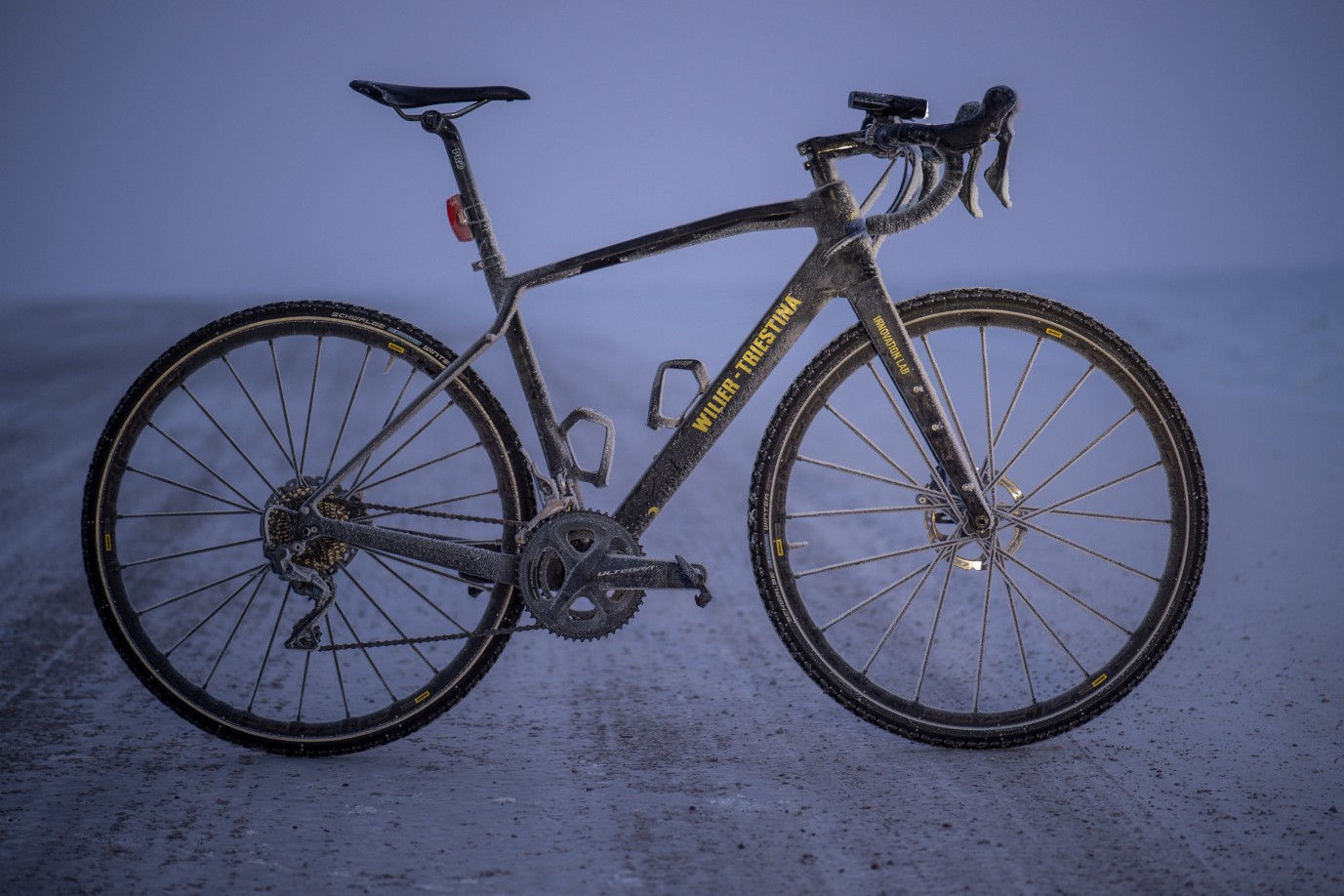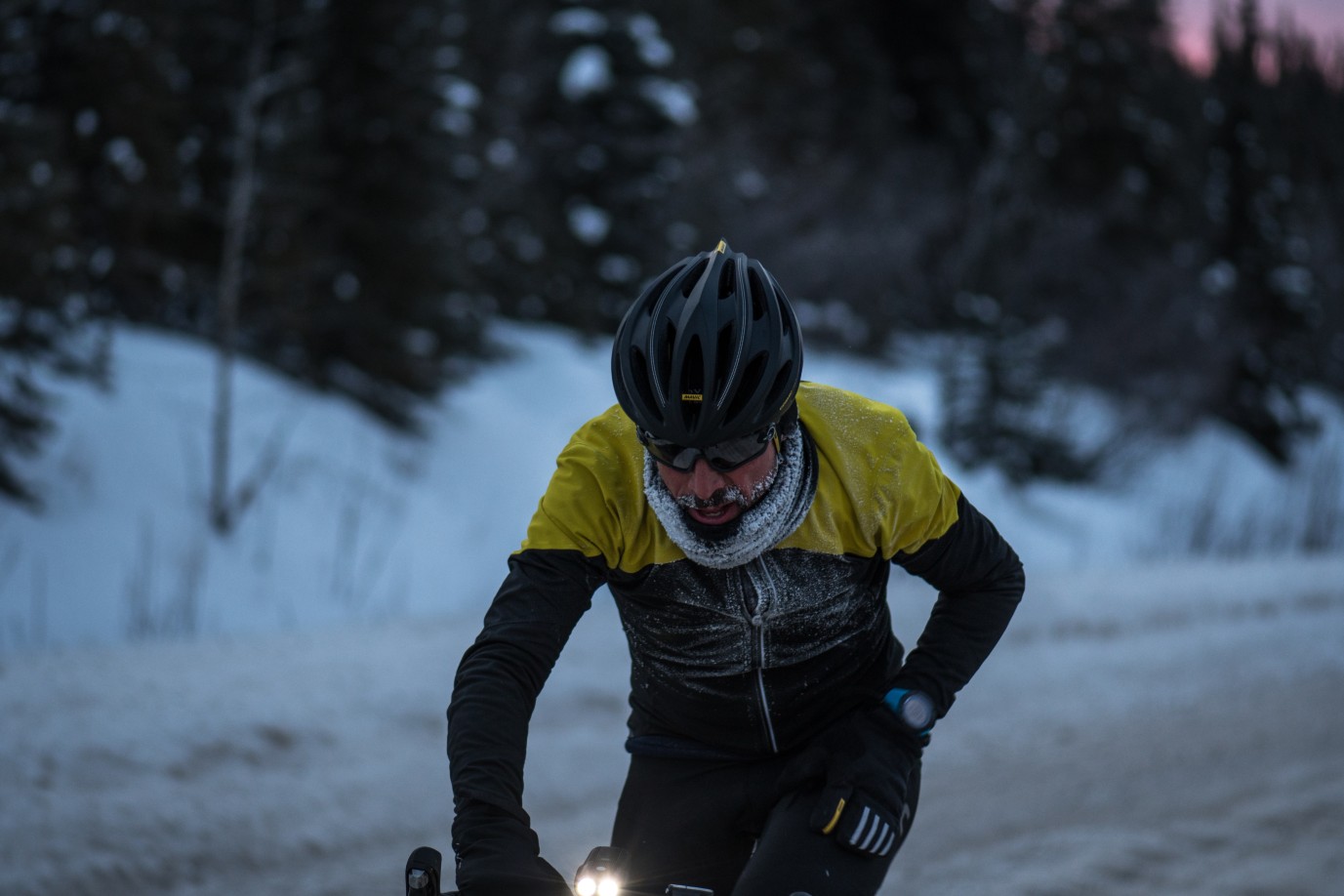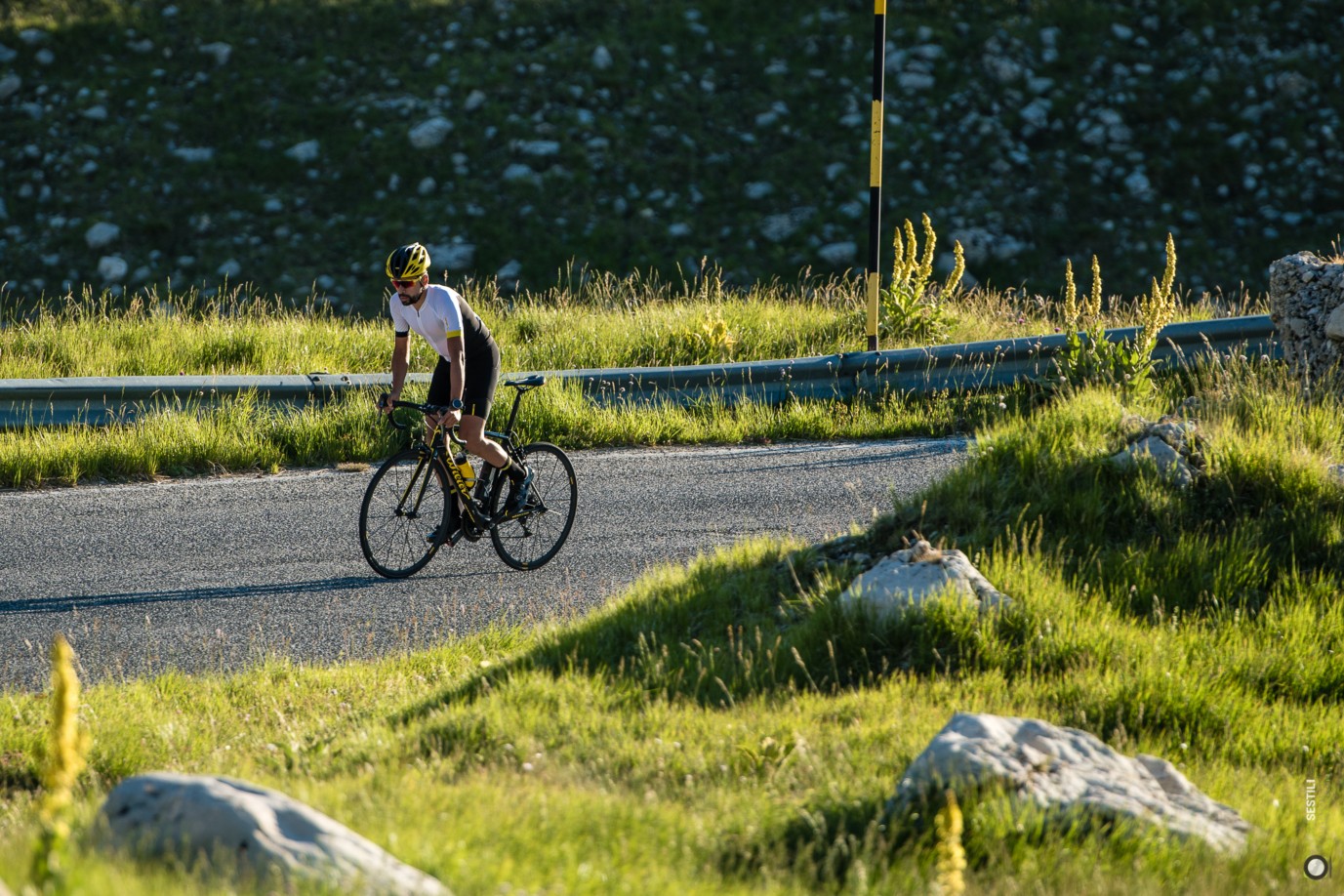One aspect of the sport we had yet to touch at We Love Cycling was the extreme “winter edition” of the sport. And since the 2018/19 winter has been rather harsh to us all both in Europe and North America, we thought that before the spring sunshine fully appears, a little taste of what winter ultracycling is all about would be more than appropriate.
Here comes Omar Di Felice, the extreme “Cold Hunter” from Rome, Italy, who has been pushing the boundaries of extreme winter cycling to the maximum (or minimum if you prefer to think about the temperatures).

You are a Rome native, which is not exactly a city renowned for its harsh winter conditions. What made you choose such types of hardcore winter ultracycling challenges?
When I was a kid, I used to watch the movies and documentaries by National Geographic (and others) on TV about these great explorations, adventurers, the hard-core skiers and climbers… It just fascinated me.
This is why some years ago, I decided to mix up my two biggest passions: cycling and exploration of the Great North. I wanted to do something unique and wanted to be a road cyclist in such extreme and cold places. You know, the Arctic is a tough but amazing place and cycling in winter up there is one of the best experiences you can live in your life. The sheer cold, the unique colours, the silence, the wind and, of course, the snow. And I must also mention the amazing Northern Lights during the night.
That’s why I told myself: “Hey, you can try to cycle up there!”.
Hunting the cold: a mental or a physical challenge
Since you’ve been doing both Nordic Challenges and “more common” ultracycling events, could you share with us how riding in the (extreme) cold is different from summer ultracycling events?
In any standard ultracycling challenges, if you’re not well trained, you won’t reach the goal. Training is the basis for this kind of sport – of course, this is also true for all sports in general). But when you are facing a ‘big wall’ like the Arctic cold and winds, along with the de facto ‘impossibility to come back home easily’, then the challenge really takes its own shape and becomes a mental one. In fact, summer and winter cycling are different in many ways but the way to approach a multi-day non-stop ride in the south of the US or an Arctic winter one is essentially the same – you have to keep the motivation inside you running high.

Look, the way I see it is this: ahead of big troubles or challenges, the normal question which comes to your mind is ‘Why I’m doing it?’ If you personally do not have the right motivation for it, then the easiest thing will be to give up. Following is the physical part which is, in fact, less difficult, to be honest. For sure you have to train but it’s something which you and I and everyone else can do. Train, recover, sleep, and repeat. This is what a sportsperson does every day.
For me, my secret is passion. A simple example; when riding at -30°C temperatures and I feel like I am in front of a big ‘wall’, then I tell myself ‘hey Omar, shut up your ghosts! You’ are doing what you dreamed since you were a baby so push on your pedals and enjoy it.’
Just to get the feel of the kind of temperatures you have been dealing with, could you tell us which was the coldest and where?
Oh, I remember well! It was -36°C during my last unsupported adventure to Northcape, in the Finnmark area in Norway, where I rode 85 km without any kind of possibility to stop as I was in the middle of nowhere. No recovery places nor gas stations between the villages of Alta and Skaidi. In such a case, if you must stop, you’re in trouble.
The Logistics
Could you describe to us what kind of a support team you have?
One official yellow MAVIC neutral assistance car. Since I am an ambassador for the brand, these guys who are part of a truly historical French brand have been helping me a great deal since many of them are part of the MAVIC official car fleet during the Tour de France. So I get the top technicians following me. They also help me with the nutrition stuff.
And the other one is a big van where the second part of the team rests, takes care of all of the refills, and so on. Pretty much everything including nutrition, clothes, replacements for the bike parts, etc. In addition, I have a photographer/technician who adds up as a mechanic in case of bike problems. Next would be my coach who has medical skills in case of first aid requirements.

Then there is my dear lady who manages all of my social network platforms during each major challenge. She takes care of the story-telling and makes sure to involve all of the people important to help promoting what ultracycling really is!
How important is your support team for realizing such feats?
I would totally agree with the fact that, generally, ultracycling is a team-based sport, like in football where the work of many people is necessary to achieve a single goal. So, in this sense, my support crew is so important to me that it is hard to explain how much they help me in completing my challenges.
For example, during long-distance challenges like the one I did in Italy (3,800 km non-stop RAAM-style), I had two support teams, which were switching every 10-12 hours so they could also rest and sleep and remain focused. This way, they have to take over at one point because I become just too tired to make sound decisions.
What are your sleeping arrangements during the challenges? How does that work?
I will be honest with you. I don’t like to power nap in the car too much but I have to sleep there most of the time (laughter). Sometimes, I did have a camper with a bed. This is why from one of my sponsors, Dorelan, I’ve received a special portable bed to increase my recovery ability after a power nap in various conditions.

The Equipment
Omar, we are definitely curious about the type of equipment you are using for your arctic events. Let’s start with your bike and bike set-up.
During my winter expeditions, I use a gravel bike as the geometry, providing a more comfortable position, is best adapted for such conditions. Last year in Canada, I tested for my sponsor Wilier a new innovative model, the Jena. A very light bike offering a good performance geometry. In this sense, it is not an endurance bike.
Regarding my groupset, because when riding in winter, the most important thing is to have the maximum reliability, I opt for a mechanical groupset, more specifically the Shimano Ultegra without electronic parts (no Di2). As for my choice of tires for icy surfaces, I use CX tires with spikes (700×30-35C with 25 spikes per tire).
Regarding the brakes, a disk brake system is just a must. During my first winter expeditions, I used a rim brake configuration and it was the worst braking experience of my life. Also and as you know, oil plays a major part in a smooth bike ride. In my case, standard oil for wet conditions is the best until -30°C. When temperatures go lower, I just have to keep my finger crossed and ride the bike more gently in order to prevent any kind of problems. For example, breaking a chain in temperatures below -30°C signals some really harsh work on the side of the road (and often in the dark)!
By the way, there is no customized part nowhere on the bike because my goal is to do these kinds of challenges as a ‘normal’ road cyclist. As for the rest of the year, when I participate in more ‘human’ conditions, I use bikes in relation to the type of challenge at hand; a standard light bike like Wilier’s Zero6 and Zero7. In the case of mountains challenges, I prefer an endurance bike like Wilier’s 110NDR. For unsupported long-distance races, I will add bike packing bags. With challenges done on flat roads, I go for a pure time trial bike.

What about your clothing?
First comes the jacket. I use a standard MAVIC Cosmic Pro jacket. Why no specific alpine-oriented equipment you may ask? For the exact same reason I mentioned before. I want to do this kind of challenge as a standard road cyclist to show that it is possible.
Next are the inside layers. This is the most important thing. It goes for me but also for any amateur cyclists looking to start with winter cycling either for fun or to commute to work. The trick is to create the first layer of insulation from the cold and wind. For this, I use a Merino wool base layer after which I select various multi-layer systems in order to calibrate, depending on the effort and the temperature I must deal with.
As for pants, it is pretty much like the jacket; I use MAVIC standard winter cycling pants. About the shoes, instead of opting for shoes and an overshoe system, I go with winter-dedicated shoes like the MAVIC Ksyrium Thermo. Now, when I am completely alone without a support team, I will often go with Crossmax MTB, because an MTB shoe is better considering that sometimes you have to walk when you reach the end point (or during some stops). Now, in order to protect my feet and toes, the Merino wool socks are really the best in this case. For sure, feet are one of the most stressed parts of your body in cold conditions and you have to pay close attention in order to avoid freezing problems.
You know, arctic cycling can be really dangerous if you do not have enough experience to evaluate your fingers’ condition, so determining when you are able to cycle and when to stop is the only way to do this safely.

The Nutrition
Do you have any special protein/fat requirements when riding in the cold or your nutrition is similar to that of a typical pro cyclist at the Giro d’Italia?
Slightly different. In winter conditions, I must drastically re-balance my food intake considering that I must reserve a bigger quota to proteins and fat. When you ride in such cold conditions, you have to consider that the weather keeps your consumption higher and higher. For me, it goes up to something like 800-1,000 kcal/hour! This is why I eat something like paninis with fatty cheese and ham. Sugar-wise, I like pieces of cake but chocolate remains my favourite during these kinds of challenges.
The Cold Hunter’s Hunting Season
Could you give us a rundown of your calendar for the last and current year?
In January 2018, I did the Iceland bike-packing adventure as training for Canada where I did a 1,400-km ride from Whitehorse to Tuktoyaktuk in March. I was, in fact, the first cyclist on the new arctic road and I am very proud of that! I did that one with the help of a support car. I must say that this was a really exhausting winter challenge.
Then, at the end of May 2018, I won the short version of the Glocknerman (500 km) and the Dolomitics 24-hour race. At the end of the season, I finished second at the Transiberica Unsupported Bike race, 3,600 km all around Spain and Portugal in a non-stop mode. Now for 2019, very soon (March 1) I am planning the Alaska Limitless, trying to cycle from Anchorage to Deadhorse facing one of the most extreme roads in the world – the Dalton Highway. It is also about 1,400 km, similar to my Canadian experience, with a support car. By the way, it is why I did the Norwegian experience in bikepacking earlier, a hard training where I found some of the most incredible weather conditions I have ever faced.
Good luck at the Alaska Limitless from the whole team, Omar!






